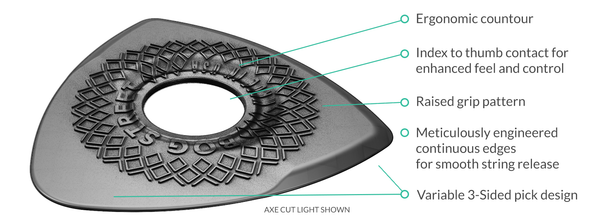Players that use a pick, understand that this simple tool is a critical link between the fine articulations of the player’s hand and the guitar strings. However, the guitar pick has remained virtually unchanged since they started gaining popularity in the 1920s.
Even companies that have been around for generations have essentially been selling slight variations of the same concept for decades. So why hasn’t this low-tech tool seen any notable innovation since inception? Why has it been treated as a cheap throw-away commodity when it’s such an important tool for the musician?
Every guitar player is a unique individual. We all have different hand sizes, grip styles, skill levels and musical preferences. We’re all different. So it doesn’t make sense that we would all use the same basic design that was conceived in the last century. We believe there’s something to be gained from a modern approach to design that starts with a fresh set of assumptions.
With all due respect to tradition, it’s time to modernize the humble guitar pick using the science of ergonomics and a human-centered design methodology to bring something new to the table. A “human-centered” design methodology means that our products are not built on top old assumptions, but designed around research, prototyping, testing and challenging conventions. Design is a tool for solving problems. And the solution starts with the needs of the player, rather than the patterns of the past.
THE PROBLEM
Your hands are a miracle of design. But no matter what your experience level is, getting a grip on a traditional flat guitar pick is a challenge. Of course, with years of practice you can learn to adapt to all kinds of challenges; but why should your pick be part of the problem?

Holding a thin, smooth, flat piece of plastic in between your thumb and index finger doesn’t sound that hard. But when you have to articulate and control that object with precision and control while strumming and attacking against the force of taut guitar strings, it becomes a bit more difficult. The increased tension required to control and articulate a standard flat pick can also cause fatigue and even pain.
Other factors can contribute to the problems a conventional flat pick can create including environmental factors such as dry or sweaty hands. And, if you’re one of the unfortunate millions of people that struggle with a hand impairment or injury, all these difficulties can be significantly amplified.
THE SOLUTION
Bog Street picks are the result of many iterations of prototype development. Our designs are refined and shaped to achieve three primary objectives:
- Improved grip security so the user can relax the picking hand to reduce tension and fatigue.
- Enhanced feel and control for improved articulation of technique
- Responsive string release and optimal tonal quality.
The Axe Series picks by Bog Street are engineered to be the optimal balance of grip security and playability.
- Curved ergonomic comfort grip area
- Anti-slip grip pattern to reduce rotation and lateral movement
- Contact between thumb and index finger for improved feel.

These unique designs are meticulously engineered for performance:
- Three-sided pick with variable thickness & tip options
- Unique tip geometry for optimal string release
And manufactured in the USA and held to the highest quality standards.
- High-grade material & finish for optimal tone
- Precision molded to industry-leading finish quality standards.
Bog Street’s mission is to enhance the guitar playing experience. Our patented pick designs are raising the bar for what players should expect from something as simple as the guitar pick. Just because something is simple, doesn’t mean it’s not important. And if you’re a player that uses a guitar pick, that simple little tool is helping you make a connection to your guitar. It becomes a virtual extension of your playing. We know that’s important to you. So it’s important to us.

